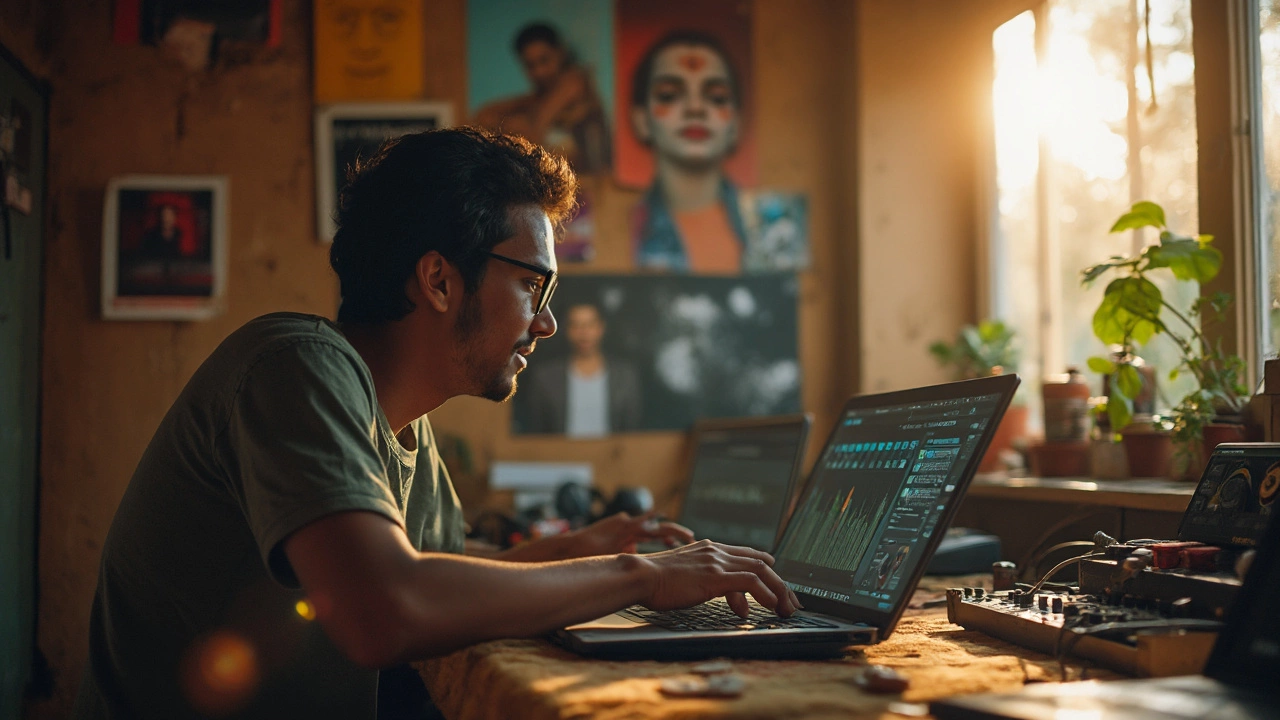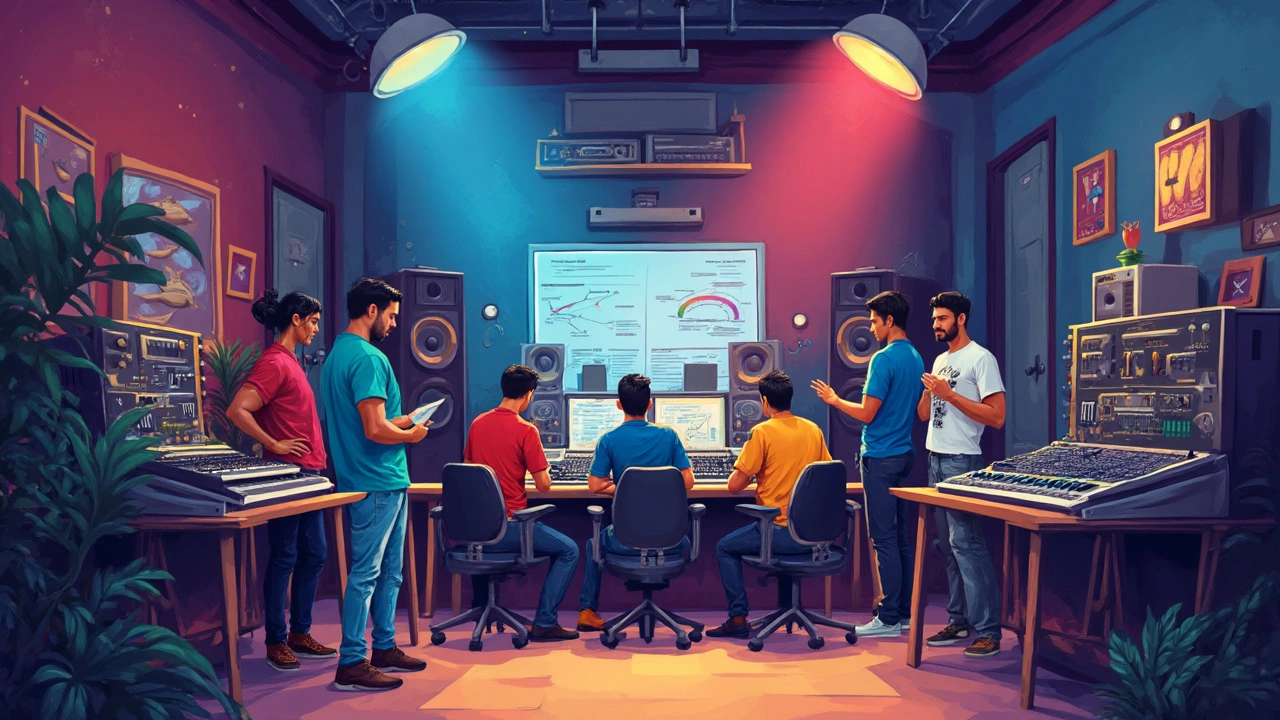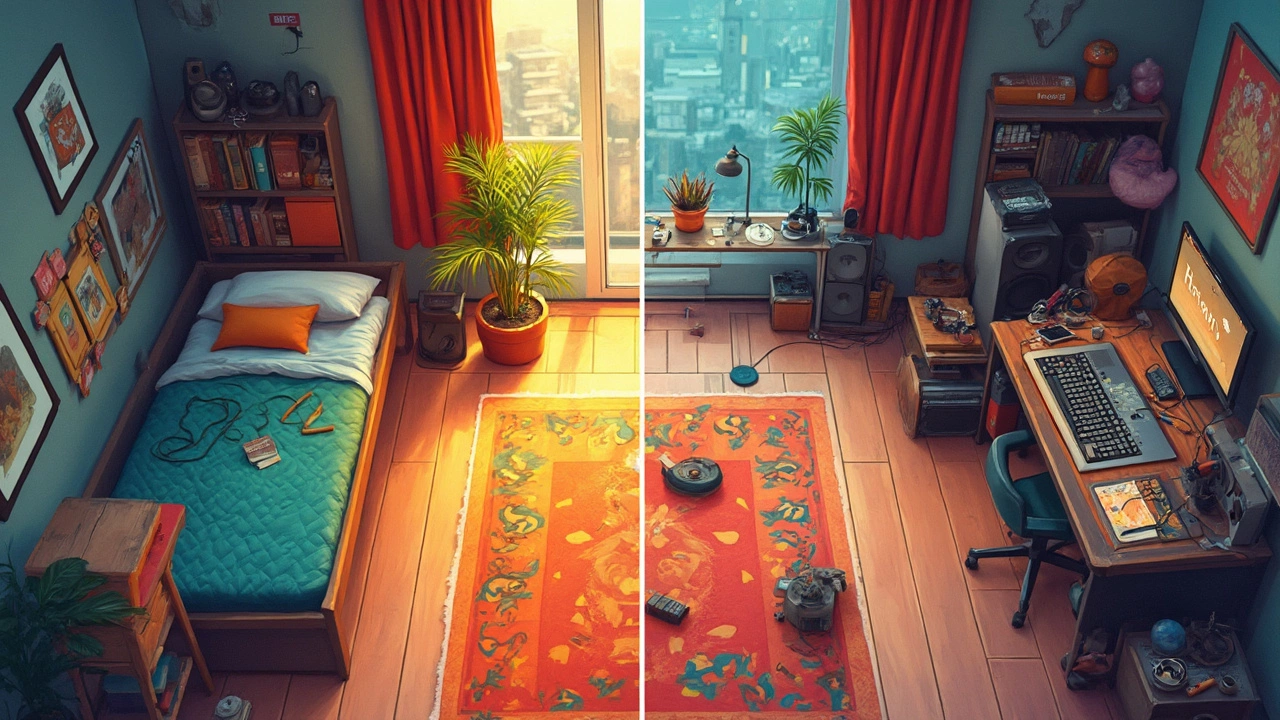Studio Setup India: How Much Would It Cost to Build a Studio?
 May, 13 2025
May, 13 2025
Ever wondered why some people spend just ₹50,000 for a home studio, while others burn through a few lakhs? The answer: it depends on what you want to make and how pro you need to sound. You don’t have to empty your bank to grab good audio—or to create a setup that feels pro enough for YouTube, podcasts, or serious music production. But skipping the basics can cost you way more in the long run.
Let’s get real about numbers. In India, building a studio is about more than buying mics and a laptop. You’ve got to budget for the room itself, sound treatment (trust me, egg cartons won’t cut it), and gear that suits your work instead of showing off. People often splurge on the wrong stuff and miss things like cables, good headphones, or power backups. That comes back to bite them later, usually in the middle of a take.
Whether you’re a bedroom producer or shooting reels, having a sense of the true costs—and where you can cut corners without regret—makes all the difference. Ignore those influencer setups worth ₹10 lakhs if all you’re doing is recording vocals or podcasts. There’s a sweet spot between barebones and high-end. Let’s break down the smartest way to spend your cash, from essentials to sneaky hidden extras.
- Different Types of Studios: What’s Your Goal?
- Room Prep and Soundproofing: Don’t Skip This
- Gear Breakdown: Must-Haves vs. Nice-to-Haves
- Real Price Tags: Sample Budgets for 2025
- Smart Ways to Save and Real-World Tips
Different Types of Studios: What’s Your Goal?
Before you even check prices, get clear about the studio you need. Not all studios are created equal, and costs swing wildly based on your goal. Are you starting a podcast, recording vocals, making full tracks, or shooting videos? Your answer changes literally everything—budget, gear, even the kind of desk you need.
Here’s a quick breakdown of the most common studio setups in India:
- Bedroom/Home Studio: Perfect if you're recording vocals, guitar, podcasts, or making beats. These usually fit into your spare bedroom or even a corner and can start as low as ₹40,000 if you focus on essentials only. Good enough for YouTube creators, online teachers, and indie artists.
- Project Studio: A step up. You’ll want a dedicated room and better soundproofing. These studios can handle full tracks, small band sessions, or advanced podcast setups. Typical budgets range from ₹1 lakh to ₹4 lakhs, depending on your ambitions.
- Professional Studio: Think commercial space, full soundproofing, top-quality gear, maybe even a vocal booth. These are for client work, album recordings, or video shoots. Here, costs shoot well past ₹10 lakhs—sometimes much higher, depending on tech and rent.
If you’re not sure yet, here’s a tip: start small, get some hands-on experience, then scale up once you know what you actually use every day. Many people in India set up ambitious studios, only to realize they needed 30% of the gear they bought.
To give you a snapshot, check out typical spends for popular studio setups right now:
| Type | Usual Purpose | Starting Cost (₹) | Space Needed |
|---|---|---|---|
| Bedroom/Home Studio | Podcast, vocals, beats, basic mixing | 40,000–1,00,000 | Small room or corner (80–120 sq ft) |
| Project Studio | Bands, music production, advanced podcasting | 1,00,000–4,00,000 | Full room (120–250 sq ft) |
| Professional Studio | Commercial recordings, albums, film audio | 10,00,000+ | Larger room or dedicated facility (250+ sq ft) |
The big point: your goal decides your spend. Going viral on Instagram? Home studio. Recording indie albums for clients? Go project studio. Want big names and lots of gear? Welcome to professional studio world—but open your wallet wide. Focus on what makes sense for your current needs, not what influencers are flexing on reels. This is where your studio setup journey really begins.
Room Prep and Soundproofing: Don’t Skip This
This is the step most newbies try to shortcut, and it always backfires. Before you even think about that shiny microphone, you need to get your room right. Good sound starts with the space itself—not your gear. In India’s typical homes, thin walls and tiled floors make echo and outside noise a serious pain.
Forget those egg cartons—those are a myth. What you need for basic isolation is simple: thick curtains, foam panels, and sealing up gaps. People on a budget often grab heavy quilts to hang behind their desk or vocal corner. It actually works as a decent homemade fix. If you’re working in a rented apartment, stick to things you can remove later. Use double-sided tape for acoustic foam or set up portable panels.
Here’s what you should look at:
- Recording studio cost India for treatment starts (as of May 2025) at around ₹8,000–₹12,000 for a small room. This gives you decent foam, bass traps, and basic heavy curtains. Pro studios spend 10x that, but most folks don’t need it.
- Seal the door gaps with rubber draft stoppers. These are cheap and make a real difference.
- If you live next to a busy road, double up your curtains or add a bookshelf full of books—it acts as a diffuser and sound blocker.
- Test the sound in the empty room—clap your hands and check if it echos for more than a second. The shorter the reverb, the better the starting point.
Vinay Kumar, head engineer at Delhi’s SoundCraft Studio, puts it simply:
"You can buy the best mic in the city, but if your room sounds like a bathroom, your recordings will too—that’s the first thing we explain to every new client."
It’s easy to get obsessed with gear, but smart room prep is what separates your stuff from amateur to pro. Skip this, and you’ll spend ages editing out background noise—if you can fix it at all.

Gear Breakdown: Must-Haves vs. Nice-to-Haves
Here’s where most folks get tripped up. You don’t actually need a mountain of gear when setting up a studio setup in India—especially if you’re starting out or working solo. It pays to know the difference between what you need right away and what’s just cool to have.
Let’s hit the must-haves:
- Audio Interface: This is the brain for your setup. Even budget models like Focusrite Scarlett Solo or Audient EVO 4 (₹9,000–₹12,000) sound good for most uses.
- Microphone: For vocals or voiceovers, a solid condenser like the Audio-Technica AT2020 (₹7,000–₹9,000) works wonders. Don’t get blinded by fancy models right away.
- Studio Monitors or Headphones: Good monitors (Yamaha HS5, starting ₹15,000 each) are great if your room’s treated. On a small budget? Go for headphones like the Audio-Technica ATH-M50x—less than ₹10,000 and dead honest about your sound.
- DAW (Digital Audio Workstation): You can grab FL Studio, Cubase, or Ableton Live Intro for under ₹8,000. There are also free options like Cakewalk, but paid ones offer better support.
- Cables, Stands, and Pop Filter: These boring extras make your life so much easier. Expect to spend about ₹2,000–₹3,000 total—don’t cheap out here, or you’ll regret it later.
Now, for the “nice-to-haves”—stuff you can add later, or when your projects demand it:
- MIDI Keyboard/Controller: Not essential unless you’re making beats, but awesome for composition. Budget ones start around ₹4,000.
- External Plugins and Effects: Most DAWs come with solid plugins. But brands like Waves or FabFilter offer upgrades when you want pro mixing—these can get pricey quick (₹7,000+ for popular packs).
- Control Surfaces: These speed up your workflow, but aren’t essential for beginners. Devices like Akai MIDImix cost around ₹6,000.
- Fancy Hardware: Tube preamps, audio racks, acoustic diffusers—only needed if you’re turning pro or taking on paid recording gigs. Otherwise, don’t stress.
- Backup Power Supply (UPS): In India’s power scene, a UPS for your system (₹3,000–₹7,000) is worth considering, especially in cities with unstable electricity.
Keep it lean at first. Stick to gear you can actually use, not what looks cool on Instagram. When you grow, your studio can grow with you.
Real Price Tags: Sample Budgets for 2025
Ready to see how your dream studio lines up with your wallet? Let's break down the money part—whether you want a basic setup in your bedroom or a full-blown professional workspace. You'll find honest numbers based on what's actually available in India right now, not outdated estimates or sponsored lists.
Here’s the thing: budgets depend on what you’re making and how picky you are about sound. But most people building a studio setup in India pick from one of these three options:
- Entry-Level Home Studio (₹50,000–₹90,000): For beginners, podcasters, or singer-songwriters. Bare minimum but good quality.
- Mid-Tier Studio for Creators (₹1.2 lakh–₹3 lakh): For small producers, serious YouTubers, or musicians needing more control.
- Pro Studio (₹5 lakh and above): For commercial work, bands, podcasts, or audio professionals making money off the space.
Here’s a straightforward table showing how those budgets usually break down by 2025 India prices:
| Item | Entry-Level (₹) | Mid-Tier (₹) | Pro (₹) |
|---|---|---|---|
| Audio Interface | 7,500–14,000 | 18,000–40,000 | 60,000–2,00,000 |
| Microphone | 3,500–8,000 | 12,000–35,000 | 45,000–2,00,000 |
| Studio Monitors/Headphones | 5,000–15,000 | 20,000–60,000 | 1,00,000–5,00,000+ |
| Sound Treatment | 8,000–18,000 | 30,000–80,000 | 1,20,000–3,00,000 |
| Computer/Laptop | 30,000–50,000 | 60,000–1,00,000 | 1,20,000–2,50,000 |
| Accessories (Cables, Stands, etc.) | 3,000–8,000 | 10,000–30,000 | 40,000–1,00,000 |
| Misc (UPS, Furniture, Lighting) | 5,000–12,000 | 18,000–40,000 | 50,000–2,00,000 |
So, the grand totals usually come out like this:
- Entry-Level: ₹50,000–₹90,000
- Mid-Tier: ₹1,20,000–₹3,00,000
- Pro: ₹5,00,000 and up (no real upper limit)
Remember, these aren’t made-up numbers. They reflect what you’d actually pay in Mumbai, Delhi, or Bangalore in May 2025, not counting major discounts or imported gear. Costs can swing either way if you hunt for used deals or invest in imported mics. The biggest mistake? Spending too much on one fancy item and then cheaping out on essentials like cables or sound treatment. Stick to a balanced budget and you’ll avoid rookie regrets.

Smart Ways to Save and Real-World Tips
If you’re putting together a studio in India, every rupee counts. People waste money on mistakes most beginners could avoid if they knew better. Here’s how you can stay sharp and stretch your budget further than you thought possible.
- Studio setup doesn’t mean buying everything new. Check sites like OLX and Facebook Marketplace—there’s a healthy second-hand market, especially in bigger cities. Loads of folks upgrade gear regularly, so you can snag quality mics, monitors, and even audio interfaces for 30-50% less than MRP.
- If you’re tight on space or budget, a single good pair of headphones is more useful than two cheap speakers. The Audio-Technica M50x is pretty much the Indian home studio staple—around ₹11,000, but worth every rupee.
- DIY your acoustic treatment. Instead of fancy foam, try thick duvets, heavy curtains, or locally made acoustic panels. For ₹3,000–₹5,000, you can dramatically cut echo in a small room.
- Group your purchases for bulk deals. Many music stores (like Bajaao, Furtados) in metro cities offer discounts if you buy a package—mics, interface, monitors—at once. Always ask, or check their websites for combo offers.
- Don’t buy stuff “just in case.” Wait until you hit a clear limit before upgrading. Most bedroom studios only need a 2-input audio interface, not an 8-channel beast.
- Power backups are underrated—one surge or cut can fry your gear. An entry-level UPS (₹2,000–₹3,000) keeps your sessions safe during those infamous power cuts.
Here's a look at honest prices in 2025 for popular gear people swear by:
| Item | Popular Model | Street Price (INR) |
|---|---|---|
| Audio Interface | Focusrite Scarlett Solo 4th Gen | ₹9,400 |
| Studio Monitors (pair) | Yamaha HS5 | ₹29,000 |
| Headphones | Audio-Technica M50x | ₹11,000 |
| Mic (Condenser) | Rode NT1-A | ₹19,500 |
| Mic Stand + Cables | Generic/Local Brands | ₹2,000 |
Skip anything future-you won't actually use. If you ever need something better, you can always upgrade it later. The best studio is one you actually use—not the most expensive or the prettiest. Stick to gear that solves your real problem today, not imaginary ones tomorrow.